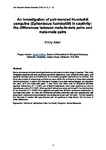An investigation of pair-bonded Humboldt penguins (Spheniscus humboldti) in captivity: the differences between male-female pairs and male-male pairs
| dc.contributor.author | Allen, E. | |
| dc.date.accessioned | 2019-05-21T09:04:09Z | |
| dc.date.available | 2019-05-21T09:04:09Z | |
| dc.date.issued | 2018 | |
| dc.identifier.citation |
Allen, E. (2018) 'An investigation of pair-bonded Humboldt penguins (Spheniscus humboldti) in captivity: the differences between male-female pairs and male-male pairs', The Plymouth Student Scientist, 11(1), p. 5-23. | en_US |
| dc.identifier.issn | 1754-2383 | |
| dc.identifier.uri | http://hdl.handle.net/10026.1/14171 | |
| dc.description.abstract |
Same-sex sexual and pair-bonding behaviours are seen in a wide range of species. This study compared opposite-sex and same-sex pair-bond behaviours, both affiliative within pairs, and agonistic between pairs and individuals, in Humboldt penguins (Spheniscus humboldti). This study also looked at where area preferences were within the enclosure to determine possible territory behaviour. A total of 200 minutes of footage of four pairs were analysed; two oppositesex pairs, and two male-male pairs. It was found that there was no difference between agonistic behaviours (P = 0.054), but affiliative behaviours were seen significantly more in opposite-sex pairs (P = 0.002). More agonistic behaviours were performed in the morning than in the afternoon (P = 0.040). Both opposite-sex pairs had different enclosure preferences to the male-male pairs. As there are differences between same-sex pair and opposite-sex pair behaviours, explanations are explored concerning same-sex pair formation. Further research into this area is needed with opposite-sex pair comparisons to help discern the functions of these behaviours. | en_US |
| dc.language.iso | en | en_US |
| dc.publisher | University of Plymouth | |
| dc.rights | Attribution 3.0 United States | * |
| dc.rights.uri | http://creativecommons.org/licenses/by/3.0/us/ | * |
| dc.subject | Pair-Bond | en_US |
| dc.subject | Same-Sex Pairs | en_US |
| dc.subject | Humboldt Penguins | en_US |
| dc.subject | Social Behaviour | en_US |
| dc.title | An investigation of pair-bonded Humboldt penguins (Spheniscus humboldti) in captivity: the differences between male-female pairs and male-male pairs | en_US |
| dc.type | Article | |
| plymouth.issue | 1 | |
| plymouth.volume | 11 | |
| plymouth.journal | The Plymouth Student Scientist |



